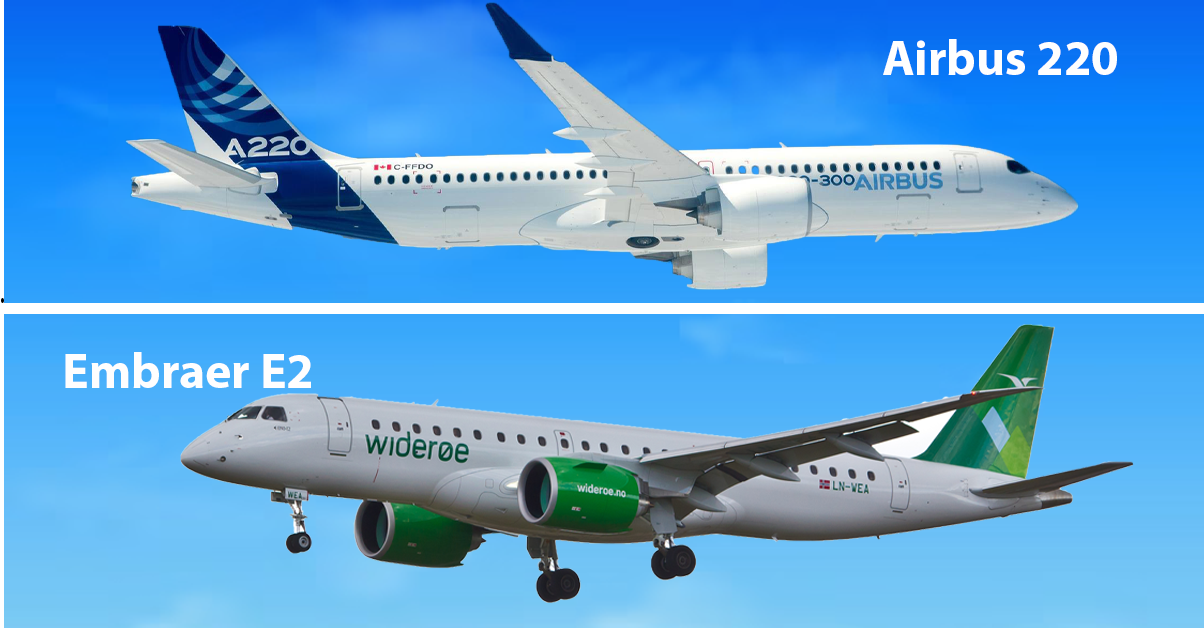The competition in regional aviation has been significantly invigorated with the advent of two advanced aircraft: the Embraer E2 series and the Airbus A220. This detailed exploration, focusing on the “Embraer E2 vs A220” rivalry, aims to dissect their design, performance, operational efficiency, and economic impact, providing insights for aviation enthusiasts and industry experts alike.
Embraer E2 vs A220
In the Embraer E2 vs A220 matchup, two modern regional jets face off, each boasting unique strengths. The Embraer E2, with its variants seating 80-146 passengers, excels in short to medium-haul efficiency, offering a comfortable 2-2 cabin layout and lower operational costs. It’s ideal for airlines focusing on regional connectivity. Check out our comparison Embraer 170 vs Embraer 175 of the to see how they differ.

Conversely, the Airbus A220, accommodating 100-150 passengers, extends its prowess to longer routes with a range of up to 3,400 nautical miles, thanks to its 2-3 cabin configuration and advanced fuel-efficient engines. This makes the A220 suitable for a wider range of operations, from regional to longer lean routes, providing versatility and greater revenue potential for airlines.
Embraer E2 vs A220 Comparison Table
| Feature | Embraer E2 Series | Airbus A220 Series |
|---|---|---|
| Passenger Capacity | 80-146 (varies by variant) | 100-150 (varies by variant) |
| Range | 2,000 – 2,600 nautical miles | Up to 3,400 nautical miles |
| Cabin Configuration | 2-2 in economy | 2-3 in economy |
| Operational Efficiency | Optimal for short-haul | Suitable for medium to long-haul |
| Cost Efficiency | Lower operational costs | Higher capacity, potentially more revenue |
| Market Segment | Regional and short-haul | Versatile |
Embraer E2
The Embraer E2 series, encompassing the E175-E2, E190-E2, and E195-E2, stands as a significant player in the regional aviation market. Designed to seat between 80 and 146 passengers, these jets are tailored for efficiency on short to medium-haul routes. A defining feature is their 2-2 seating configuration, enhancing passenger comfort by eliminating the middle seat.

The E2 series boasts advancements in aerodynamics and engine technology, leading to reduced fuel consumption and emissions, aligning with contemporary environmental concerns. Ideal for regional airlines, the E2 series offers operational flexibility and cost-effectiveness, making it a strategic choice for routes with varying passenger demands.
Airbus A220 Series
The Airbus A220 series, comprising the A220-100 and A220-300 models, presents a compelling proposition in the modern regional and medium-haul market segments. With a capacity of 100 to 150 passengers and an impressive range of up to 3,400 nautical miles, the A220 is versatile enough to cover a broad spectrum of routes.

The aircraft features a unique 2-3 seating configuration, providing enhanced passenger comfort and space. Equipped with state-of-the-art geared turbofan engines, the A220 excels in operational efficiency, offering significant reductions in fuel burn and noise, making it an attractive option for airlines aiming to expand their operations with an eye on sustainability and profitability.
Design and Comfort Embraer E2 vs A220
Embraer E2: The Embraer E2 series, a strategic evolution from its E-Jet predecessors, emphasizes passenger comfort and advanced design. The cabin’s 2-2 seating configuration is a testament to its focus on passenger comfort, making it a preferred choice for travelers on regional routes. The attention to cabin space, noise reduction, and overall ambiance places it at the forefront of regional jet design.
Airbus A220: The Airbus A220, initially launched as the Bombardier C Series, redefines passenger experience in the regional jet segment. Its 2-3 seating configuration in economy class offers a unique blend of comfort and capacity. Large windows, spacious overhead bins, and advanced cabin lighting enhance the travel experience, setting new standards in the regional aviation market.
Performance, Capacity, and Range
Embraer E2: The E2 family, including the E175-E2, E190-E2, and E195-E2, covers a broad spectrum, seating 80 to 146 passengers. Each variant is designed to optimize performance for specific route lengths, with a range extending from 2,000 to 2,600 nautical miles. These aircraft are perfect for short to medium-haul operations, offering flexibility and efficiency.
Airbus A220: The A220 series, with the A220-100 and A220-300 models, serves a slightly different market segment. Accommodating 100 to 150 passengers and boasting a range of up to 3,400 nautical miles for the A220-300, the A220 is capable of longer, more demanding routes, providing airlines with more operational versatility.
Tech and Efficiency
Embraer E2: The E2 series is a showcase of Embraer’s commitment to technological innovation. The aircraft features state-of-the-art aerodynamics, next-generation engines, and advanced avionics. These contribute to its remarkable fuel efficiency and reduced emissions, making it a sustainable choice for regional airlines.
Airbus A220: Similarly, the A220 is equipped with cutting-edge technology. Its geared turbofan engines, advanced materials, and aerodynamic design significantly lower fuel consumption and emissions. This efficiency is particularly beneficial for airlines looking to maintain profitability while adhering to stringent environmental regulations.
Airline Economics and Operations
Embraer E2: With its lower operational costs, the E2 series is an economical powerhouse for regional and low-demand routes. Its cost-effectiveness is a vital factor for airlines aiming to enhance regional connectivity without incurring excessive costs.
Airbus A220: The A220, while bearing a higher price tag, offers a compelling economic proposition with its higher passenger capacity and extended range. It opens up new route possibilities for airlines, combining the efficiency of regional jets with the capabilities of larger single-aisle aircraft.
Role in Modern Airline Fleets
Embraer E2: The E2 series finds its niche in regional and smaller airlines, enhancing their ability to serve short to medium-haul routes with unparalleled efficiency and lower environmental impact.
Airbus A220: The A220’s versatility makes it an attractive option for a diverse range of carriers. It can effortlessly fit into the fleet of both regional and larger airlines, serving not just short-haul but also medium to long-haul routes that require greater capacity.
Embraer E2 vs A220 Pros and Cons
Embraer E2
- Pros:
- Ideal for regional and lower-demand routes.
- Enhanced passenger comfort in a 2-2 seating configuration.
- Lower operational costs on short-haul routes.
- Good airport accessibility due to its smaller size.
- Cons:
- Limited range compared to the A220.
- Lower passenger capacity might not be suitable for high-density routes.
A220
- Pros:
- Greater range and passenger capacity.
- Fuel-efficient with reduced environmental impact.
- Flexible for both regional and longer routes.
- Modern cabin design enhances passenger experience.
- Cons:
- Higher costs compared to smaller regional jets.
- Requires more infrastructure than smaller aircraft like the E2.
Embraer E2 vs A220 Price Comparison
Embraer E2 Price
The cost of acquiring and operating an Embraer E2 is generally lower, making it a cost-effective option for airlines focusing on regional networks. The aircraft’s lower price point and operational efficiency ensure that it remains an economical choice for smaller carriers or those with specific route requirements.
Airbus A220 Price
The A220, while more expensive in terms of list price, offers long-term economic benefits through its fuel efficiency and versatility in route planning. For airlines looking to invest in a future-proof fleet capable of operating a diverse range of routes efficiently, the A220 presents a viable option despite its higher initial cost.
Conclusion
The “Embraer E2 vs A220” comparison reveals that both aircraft are engineered to meet distinct yet overlapping segments of the aviation market. The E2 series, with its emphasis on operational efficiency and sustainability, is a compelling choice for regional airlines focusing on short to medium-haul routes. On the other hand, the Airbus A220, with its larger capacity and extended range, is an all-rounder, adept at serving a wide range of routes, from regional hops to longer, lean routes. Both aircraft are not just feats of engineering; they are strategic tools for airlines to navigate the complexities of modern air travel, offering flexibility, efficiency, and an enhanced passenger experience.



